|
|
Birdcatcher

|
|
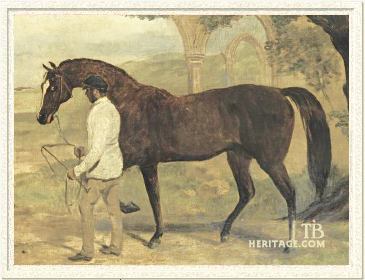 |
|
|
This champion of the Emerald Isle has been proudly referred to as "Irish Birdcatcher," for over 150 years and while he dominated the Curragh as a racehorse, his influence as a stallion went far beyond Ireland's shores. Through his son, The Baron, Birdcatcher became the grandsire of Stockwell, the "Emperor of Stallions." Beyond that, his influence can be seen any day at any track or farm, when one of his descendants, bearing the famous "Birdcatcher ticks" walks into the winner's circle or breeding shed. |
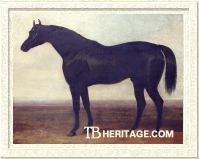
Sir Hercules
|
|
Birdcatcher was foaled in 1833 at Brownstown Stud, located on the Curragh in Ireland, when the farm was owned by his breeder George Knox. Birdcatcher was a son of resident Brownstown stallion Sir Hercules, another Irish-bred stallion whose only loss, in the St. Leger of 1829, is generally considered to have been the result of being "got at" prior to the race, beaten as he was by Rowton and Voltaire. Sir Hercules was a black colt with a star, although he was sometimes referred to as "grey or black" due to the large number of silvery grey hairs spread throughout his coat and at the base of his tail.
|
Birdcatcher is considered Sir Hercules' most important son, but the black stallion also sired Birdcatcher's full brother, Faugh-a-Ballagh, who became the first Irish-bred winner of an English classic when he won the St. Leger of 1844. ("Faugh a Ballagh" is an Irish/Gaelic battle cry meaning "clear the way!" and the pronunciation is something like: Fawg a BOLLagh.) Faugh-A-Ballagh sired the English and French Oaks winner Fille de l'Air, herself dam of Oaks and 1,000 Guineas winner Reine, but Faugh-A-Ballagh is best remembered as the sire of the good stayer *Leamington, who became the Leading Sire in America on four different occasions. The sireline is full of landmarks events, since one of *Leamington's best sons was Iroquois, who became the first American-bred winner of an English classic when he won the Derby and St. Leger Stakes in 1881.
Birdcatcher's dam was Guiccioli, a chestnut daughter Bob Booty and Flight by Escape. In fact, she was inbred 3x3 to Bagot, sire of the dam of both her parents. She was also extensively linebred 4x4x5x5x4x4 to Herod. Ulbrich notes that she "ran exceptionally well from two to six years." Besides Birdcatcher and Faugh-A-Ballagh, Guiccioli produced their full sister, Gramachree (1844) one of a pair of surviving twins. Gramachree's grandson Selim became the first winner of the Irish Derby in 1866, yet another milestone.
Guiccioli was 10 years old when she gave birth to Birdcatcher, her fifth foal. As a yearling, he became seriously ill and nearly died from a respiratory infection, but surprised everyone by surviving to not only race, but to excel.
Birdcatcher came into the ownership of William Disney, whose Lark Lodge was adjacent to Brownstown. The colt was unplaced in 1 start as a juvenile. At 3, racing strictly at the Curragh, he broke his maiden in a division of the Madrid Stakes, followed by a win in the Milltown Stakes, which prompted the arrangement of a match between Birdcatcher and Cushniche, who he had defeated in the Milltown. Cushniche's owner forfeited and Disney pocketed the cash.
The Sir Hercules colt was next second in the Wellington Stakes (10 furlongs), losing by a hard fought head to Maria. Then he put in an awe-inspiring performance winning the Peel Stakes (14 furlongs). According to John Osborne, an observer, Birdcatcher "...jumped off in front and though not a hard puller, got so excited that he ran away. After he had passed the winning post his jockey could not pull him up. Birdcatcher ran another mile down the precipitous back road to Newbridge." He was back in action the next day, but, not surprisingly for a recent runaway, performed out of character, finishing out of the money in the Mulgrave Handicap. In his final start at 3, Birdcatcher was second, then was put away for the season.
At age four, Birdcatcher debuted with a win in the Kildare Stakes, walked-over in the Wellington Stakes, and won a Royal Plate before bowing to the famous Harkaway in the Northumberland Handicap. Beaten back to third in his next 2 outings, once to Harkaway and once to Mercury, the chestnut was unplaced in the Doris Stakes, which was to be his final start. His complete record read 15 starts, 7 wins, and a reputation as a horse which, on his best day, was peerless. |
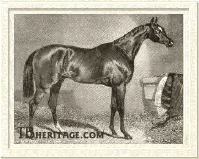
The Baron won the St. Leger and later sired Stockwell and Rataplan
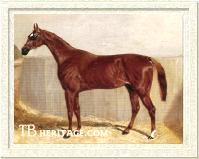
14.2. hands high, Daniel O'Rourke won the 1852 Derby and the St. James' Palace Stakes at Ascot, and was later exported to Hungary
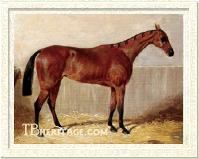
Songstress won the 1852 Oaks and the Triennial Stakes at Ascot
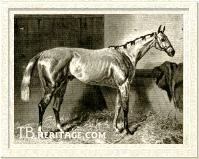
The grey Chanticleer was a top stayer of "unbounded courage" who won the Goodwood Stakes and Doncaster Cup, among other races.
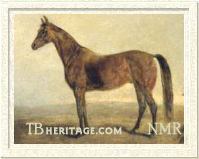
Knight of St. George went to the U.S. Image courtesy National Museum of Racing. Used with permission.
|
|
Birdcatcher retired to stud alongside his sire, Sir Hercules, at Brownstown Stud when a 5-year-old in 1838. When his early runners began to show great form, including 1845 St. Leger winner THE BARON, and Doncaster Cup winner CHANTICLEER, the Irish stallion was moved to Barrow's Paddocks in Newmarket, England, for the 1846 and 1847 seasons. In 1848 and 1849, he was leased to stand at Easby Abbey, near Richmond in Yorkshire. His English crops bore quick fruit, including 1852 Derby winner DANIEL O'ROURKE, plus that year's Oaks winner SONGSTRESS, and Park Hill Stakes winner BIRD ON THE WING (second in the Oaks to Songstress), giving him the Champion Sire title for 1852.
Returning to Brownstown for 1850, Birdcatcher's next Irish crop included *KNIGHT OF ST. GEORGE, who crossed the Irish Sea to win the St. Leger in 1854. Then he got Habena, winner of the 1,000 Guineas in 1855. Sent back to England for the 1852 season, Birdcatcher had another triumphant year in 1856, when MANGANESE won the 1,000 Guineas and Warlock won the St. Leger, leading him to another Champion Sire title. Later crops included Goodwood Cup winner SAUNTERER, Park Hill Stakes winner LADY TRESPASS, OXFORD, MISS AGNES, RED EAGLE, and MARQUIS. He was sent back to Ireland after the 1859 season.
Several of Birdcatcher's sons proved effective stallions. First and foremost was THE BARON, who sired the brothers Stockwell and Rataplan out of the great mare Pocahontas, and who became a classic sire in France as well. It's through Stockwell that Birdcatcher's sireline comes to the forefront in the breed today through Doncaster, Phalaris, Teddy, Native Dancer, and Nearco. The grey-coated CHANTICLEER sired St. Leger winner Sunbeam. SAUNTERER sired Oaks winner Gamos and Prix de Diane winner Little Agnes. OXFORD sired Sterling and Nuneham. Both *MICKEY FREE and *KNIGHT OF ST. GEORGE were sent to America and met with some success there.
Daughters of Birdcatcher were equally important. FOINNUALLA was the dam of Oaks winner Mincepie. MRS. RIDGWAY produced Vedette and Qui Vive. PARTLET produced Prix de Diane winner Jeune Premier. DARLING'S dam produced Solon, Xenophon, and Bon Accord. ENGLAND'S BEAUTY produced Kingston and The Rake. AYACANORA produced Chattanooga and Sir Amyas. REINE BLANCHE produced Prix du Jockey Club winner Florentin.
An account of Birdcatcher's death in 1860, at the age of 27, was given by Patrick Connolly. "Among the mares sent to the son of Sir Hercules that year was Mr Michael Dunne's Queen Bee. She was a mare of good size, and when Birdcatcher attempted to serve her, he failed to do so. Mr Disney, who owned the stallion, thereupon decided that he should no longer survive. At once a messenger was despatched to the local police station with orders to bring back with him a constable with a loaded gun, as a horse was required to be destroyed. The policeman - his name was Preston - reported himself to Mr Disney, who gave the necessary directions for the destruction of Birdcatcher. The horse was placed on the brink of a sandpit situated on the flat opposite Conyngham Lodge, Curragh; without any ceremony he was shot and his carcase tumbled into the pit. Thus ended the career of a good racehorse and a mighty sultan at the age of twenty-seven years. His head was afterwards presented to the Royal College of Veterinary Surgeons, Dublin."
At maturity, Birdcatcher was 15.3 hands, and was an eye-catcher in all respects. He was elegant refinement and perfection of form combined with prodigious masculine strength and power. Although his own racing ability appears to have been compromised by his runaway victory in the Peel Stakes as a 3-year-old, he was from staying lines, and he passed on this classic stamina generously as evidenced by his 3 St. Leger-winning sons.
|
While his sire, Sir Hercules was black, Birdcatcher was a dark chestnut with a large star, narrow connecting blaze, and a stocking on his left hind leg. His flanks were, like his sire's, shot with grey hairs, and white hairs were also prominent like a brush at the root of his tail. This characteristic "ticking," which identifies the expression of the gene pattern referred to as "rabicano," was noted frequently in contemporary descriptions of the horse and was so prominent in many of his offspring and descendants, that it came to be known as "Birdcatcher Ticks." (Some refer to "Birdcatcher Spots" to identify the small white spots that randomly appear on some horses in a spontaneous manner. These white spots are not Birdcatcher Ticks, but something different.)
His son, Daniel O'Rourke was marked with the distinctive white ticking, as were many descendants of Stockwell. These ticks are also seen in the descendants of Birdcatcher's "nephew" Leamington (son of Faugh-a-Ballagh), such as the champion filly Susquehanna. Other prominent horses with Birdcatcher ticks include Stedfast, St. Frusquin, Pilate, Bois Roussel, Carrier Pigeon, Cox's Ridge, Doyoun, and Slew City Slew. [The bloodline of Venison (1833) is also noted for white ticking, descendants including the similarly-marked Lesterlin. A comparison of the pedigrees of Birdcatcher's sire Sir Hercules and Venison reveal some remarkable similarities, although the ultimate source of the markings remains a question.]
--Anne Peters |
|
|
|

